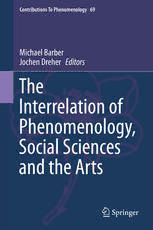
The Interrelation of Phenomenology, Social Sciences and the Arts PDF
Preview The Interrelation of Phenomenology, Social Sciences and the Arts
Contributions To Phenomenology 69 Michael Barber Jochen Dreher Editors The Interrelation of Phenomenology, Social Sciences and the Arts The Interrelation of Phenomenology, Social Sciences and the Arts CONTRIBUTIONSTOPHENOMENOLOGY INCOOPERATIONWITH THECENTERFORADVANCEDRESEARCHINPHENOMENOLOGY Volume69 SeriesEditors: NicolasdeWarren,KatholikeUniversiteitLeuven,Belgium DermotMoran,DublinUniversity,Ireland EditorialBoard: LilianAlweiss,TrinityCollegeDublin,Ireland ElizabethBehnke,Ferndale,WA,USA MichaelBarber,St.LouisUniversity,MO,USA RudolfBernet,Husserl-Archief,KatholiekeUniversiteitLeuven,Belgium DavidCarr,EmoryUniversity,GA,USA Chan-FaiCheung,ChineseUniversityHongKong,China JamesDodd,NewSchoolUniversity,NY,USA LesterEmbree,FloridaAtlanticUniversity,FL,USA AlfredoFerrarin,Universita`diPisa,Italy BurtHopkins,SeattleUniversity,WA,USA Jose´Huertas-Jourda,WilfridLaurierUniversity,Canada Kwok-YingLau,ChineseUniversityHongKong,China Nam-InLee,SeoulNationalUniversity,Korea DieterLohmar,Universita¨tzuKo¨ln,Germany WilliamR.McKenna,MiamiUniversity,OH,USA AlgisMickunas,OhioUniversity,OH,USA J.N.Mohanty,TempleUniversity,PA,USA JunichiMurata,UniversityofTokyo,Japan ThomasNenon,TheUniversityofMemphis,TN,USA ThomasM.Seebohm,JohannesGutenberg-Universita¨t,Germany GailSoffer,Rome,Italy AnthonySteinbock,SouthernIllinoisUniversityatCarbondale,IL,USA ShigeruTaguchi,YamagataUniversity,Japan DanZahavi,UniversityofCopenhagen,Denmark RichardM.Zaner,VanderbiltUniversity,TN,USA Scope Thepurposeoftheseriesistoserveasavehicleforthepursuitofphenomenologicalresearch acrossabroadspectrum,includingcross-overdevelopmentswithotherfieldsofinquiry suchasthesocialsciencesandcognitivescience.Sinceitsestablishmentin1987,Contributions toPhenomenologyhaspublishednearly60titlesondiversethemesofphenomenologicalphilosophy.Inadditionto welcomingmonographsandcollectionsofpapersinestablishedareasofscholarship, theseriesencouragesoriginalworkinphenomenology.ThebreadthanddepthoftheSeriesreflectstherichandvaried significanceofphenomenologicalthinkingforseminalquestionsofhumaninquiryaswellastheincreasingly internationalreachofphenomenologicalresearch. Forfurthervolumes: http://www.springer.com/series/5811 Michael Barber (cid:129) Jochen Dreher Editors The Interrelation of Phenomenology, Social Sciences and the Arts 123 Editors MichaelBarber JochenDreher Philosophy SocialScienceArchive St.LouisUniversity UniversityofKonstanz St.Louis,USA Konstanz,Germany ISSN0923-9545 ISBN978-3-319-01389-3 ISBN978-3-319-01390-9(eBook) DOI10.1007/978-3-319-01390-9 SpringerChamHeidelbergNewYorkDordrechtLondon LibraryofCongressControlNumber:2013946715 ©SpringerInternationalPublishingSwitzerland2014 Thisworkissubjecttocopyright.AllrightsarereservedbythePublisher,whetherthewholeorpartof thematerialisconcerned,specificallytherightsoftranslation,reprinting,reuseofillustrations,recitation, broadcasting,reproductiononmicrofilmsorinanyotherphysicalway,andtransmissionorinformation storageandretrieval,electronicadaptation,computersoftware,orbysimilarordissimilarmethodology nowknownorhereafterdeveloped.Exemptedfromthislegalreservationarebriefexcerptsinconnection with reviews or scholarly analysis or material supplied specifically for the purpose of being entered and executed on a computer system, for exclusive use by the purchaser of the work. Duplication of this publication or parts thereof is permitted only under the provisions of the Copyright Law of the Publisher’slocation,initscurrentversion,andpermissionforusemustalwaysbeobtainedfromSpringer. PermissionsforusemaybeobtainedthroughRightsLinkattheCopyrightClearanceCenter.Violations areliabletoprosecutionundertherespectiveCopyrightLaw. Theuseofgeneraldescriptivenames,registerednames,trademarks,servicemarks,etc.inthispublication doesnotimply,evenintheabsenceofaspecificstatement,thatsuchnamesareexemptfromtherelevant protectivelawsandregulationsandthereforefreeforgeneraluse. While the advice and information in this book are believed to be true and accurate at the date of publication,neithertheauthorsnortheeditorsnorthepublishercanacceptanylegalresponsibilityfor anyerrorsoromissionsthatmaybemade.Thepublishermakesnowarranty,expressorimplied,with respecttothematerialcontainedherein. Printedonacid-freepaper SpringerispartofSpringerScience+BusinessMedia(www.springer.com) Contents Introduction ...................................................................... 1 MichaelBarberandJochenDreher PartI AestheticsandtheSocialSciences Irrelevant Spheres and Vacancies of Artworks: PhenomenologicalAestheticsRevisited........................................ 11 MasatoKimura CulturalScienceinLiteraryLight............................................. 21 LesterEmbree Projection, Imagination, and Novelty: Towards a Theory ofCreativeActionBasedonSchutz............................................ 31 HubertKnoblauch ImaginationandtheSocialSciences ........................................... 51 HisashiNasu FunctionalPurposelessness:The“PracticalMeaning”ofAesthetics...... 69 Hans-GeorgSoeffner ArtasaParadoxicalFormofCommunication ............................... 83 IljaSrubar When Sociology Meets the Work of Art: Analytical FrameworkstoStudyArtisticProductionandReception................... 95 AnnaLisaTota PartII Literature Crossing the Finite Provinces of Meaning: Experience andMetaphorizingofLiteratureandArts.................................... 117 GerdSebald v vi Contents Sancho Panza and Don Quixote: The Documentary andthePhenomenologicalMethodsofAnalyzingWorksofArt ........... 129 AmaliaBarboza LiteratureasSocietalTherapy:Appresentation,Epoche´,andBeloved.... 143 MichaelBarber The Man Without Qualities and the Problem of Multiple Realities:AlfredSchutzandRobertMusilRevisited ........................ 157 MartinEndress EntangledintoHistoriesortheNarrativeGroundsofMultiple Realities ........................................................................... 173 AnnetteHilt “TheUniversethatOthersCalltheLibrary”:Reconstructing theSymbolicMystificationsoftheWorldofEverydayLife................. 195 JochenDreher PartIII Music TheTuning-inRelationship:FromaSocialTheoryofMusic TowardsaPhilosophicalUnderstandingofIntersubjectivity............... 209 CarlosBelvedere MutualTuning-InRelationshipsandPhenomenologicalPsychology...... 229 Chung-ChiYu Music,Meaning,andSociality:FromtheStandpointofaSocial Phenomenologist ................................................................. 243 AndreasGoettlich ArtisticPractice,Methodology,andSubjectivity:The“ICan” asPracticalPossibilityandOriginalConsciousness ......................... 259 AndreasGeorgStascheit MusicalFoundationofInteraction:MusicasIntermediaryMedium...... 267 MototakaMori PartIV FilmandPhotography InterpretingFilm:TheCaseofCasablanca................................... 281 GeorgePsathas APhenomenologicalInquiryofRashomon ................................... 295 Ken’ichiKawano Contents vii TheArtofMakingPhotos:SomePhenomenologicalReflections........... 311 ThomasS.Eberle AuthorIndex...................................................................... 321 SubjectIndex..................................................................... 325 Introduction MichaelBarberandJochenDreher Thepapersinthisvolumewerepresentedattheinternationalandinterdisciplinary conference “Phenomenology, Social Sciences, and the Arts,” and they focus on the specific interrelationship of a philosophical, epistemological position and a particular social scientific perspective with distinct analytical potential to investi- gate art phenomena. The phenomenological perspective allows reflection on the subjective point of view of artists and interpreters because of its reflections on the eidetic features of consciousness and on such objective structures as the field of aesthetics, communication, meaning, finite provinces of meaning, music, and literature, because all of these structures lend themselves to the kind of eidetic, oressential-philosophicalanalysisforwhichphenomenologyisknown.Thesocial scienceperspectivebycontrastexaminestheempirical,socio-historicpreconditions of the triad: artist and interpreter, and the objectified work of art. The theory of the life-world developed in the interface of phenomenology and social sciences, viaaneideticphenomenologicalanalysis,allowsaninterpretationofdiversereality spheres involved in the work of art, thus describing the symbolically established meaningstructurewhichisresponsibleforthefunctionoftheartworkassuch. Themostsignificantsocialscientistandphilosopherdedicatedtotheanalysisof interrelations between phenomenology and social science was Alfred Schutz, the fiftiethanniversaryofwhosedeathwascommemoratedatthisconference.Aspart of his work he used phenomenology to describe the epistemological foundations of social science, in particular Max Weber’s concept of social action, which he took to be the nucleus of social science. Furthermore, Schutz developed a theory ofthelife-world,aswellasatheoryofsignandsymbol,andanaccountofmultiple M.Barber((cid:2)) Philosophy,St.LouisUniversity,Lindell3800,St.Louis63156-0907,USA e-mail:[email protected] J.Dreher((cid:2)) SocialScienceArchive,UniversityofKonstanz,Konstanz78457,Germany e-mail:[email protected] M.BarberandJ.Dreher(eds.),TheInterrelationofPhenomenology,SocialSciences 1 andtheArts,ContributionstoPhenomenology69,DOI10.1007/978-3-319-01390-9 1, ©SpringerInternationalPublishingSwitzerland2014 2 M.BarberandJ.Dreher realities – all of which especially serve the interpretation of art phenomena; in relation to this, Schutz’s work on literature and music, in particular, became most crucial. Especially well-known among researchers in phenomenology and social sciencearehisanalysesofmultiplerealitysphereswithinDonQuixote,aswellas hisinterpretationofMozart’soperas.Onecentralthesissupportedbythetheoretical frameworkoftheconferenceandinthisbookisthattheanalysisofproduction,as wellastheperceptionandinterpretationofartwork,needstotakeintoconsideration thesubjectiveviewpointoftheartist,inadditiontothatoftheinterpreter. Alsorelyingontheeideticallydepictedlife-worldthatincludesthesubjectively centered viewpoints of individuals inhabiting various provinces of meaning, phe- nomenologyanalyzestheessential,philosophicalfeaturesofliterature,literaryarts forms and their relationships to social sciences, art as communication, creative action, imagination, the aesthetic sphere, narrative, symbol systems, metaphor, finiteprovincesofmeaning,intersubjectiverelationships,artisiticvalue,thevisual arts, music, and the practicing of music. The perspective of social science, by contrast, discloses the empirical, socio-historical conditions at play in the creation and reception of the art work. Weberian social science, though, examines such conditionsastheyappearinthemeaningwhichactorsgivetotheiractsasopposed to the meaning that an observer might give to such acts and thereby converges with a phenomenological focus on consciousness. The specific theoretical focus which combines both the disciplines of phenomenology and social science offers an innovative framework for the analysis of art phenomena, and makes possible a creativeinterpretationofavarietyofdistinctartformsandworks,inadditiontothe realizationoftheoreticalreflectionsontheinterdependenceofarts,phenomenology, andsocialscience. The conference was unique in that junior scholars presented papers on which senior scholars commented. This volume begins with several papers focusing on general questions of the nature of aesthetics and the relationship between phenomenology,thesocialsciences,andthearts.Asecondsectionpresentsvarious papersonliterature,athirdsectiontreatsmusic,andafourthfilmandphotography. Several authors discuss the character of aesthetics and its relationship to social scienceandphenomenology.MasatoKimuraauthorstheessay“IrrelevantSpheres and Vacancies of Artworks” which reviews the aesthetical theories of W. Conrad and R. Ingarden, both of whom battled psychologistic approaches to art. Their views, which recognize the “blanks” in works of art, open the door to the Konstanz reception theory of literature that involves an interplay, fitting for a phenomenological approach, between object and subject, between art work and interpreter, whose relevance-system, as Schutz described it, plays a crucial role in interpretation. In his essay, “Cultural Science in Literary Light,” Lester Embree develops a Wissenschaftslehre by showing how the three literary art-forms that Schutz treats in his outline “Sociological Aspects of Literature,” namely, poetry, drama, and the novel can be correlated with and can illuminate the cultural sci- ences of psychology, social science, and history. Hubert Knoblauch’s “Projection, Imagination, and Novelty: Toward a Theory of Creative Action Based in Schutz,” develops Schutz’s theory of action by showing how it might be of use to explain
